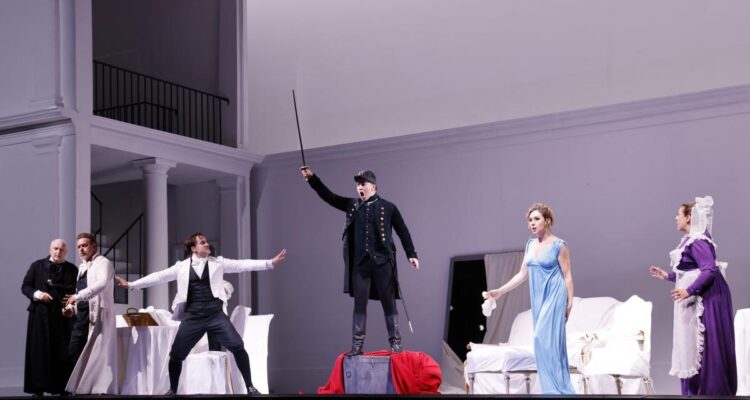Pesaro is the Italian Capital of Culture 2024, and to mark the occasion, the city is presenting four operas instead of the usual three, alongside numerous concerts. Among these is Rossini’s The Barber of Seville, a staple of the operatic repertoire, brilliant from start to finish. The opera’s theme was groundbreaking in its time, contrasting a declining aristocracy with the rise of democracy. The politically incorrect marriage between Count Almaviva and Rosina, who lacks aristocratic lineage, was a significant statement. Almaviva sees Rosina in town, falls in love, follows her home, and with the help of Figaro, manages to outwit her guardian Bartolo, who intends to marry her for her dowry.
This revival of Pier Luigi Pizzi’s elegant 2018 production is predominantly in black and white, with two balconied houses flanking the stage. Almaviva appears from one, bare-chested, encouraging Fiorello below to lead a serenade for Rosina, who lives in the opposite house. When Figaro arrives, he too strips off to wash in the public fountain outside Bartolo’s home. The frequent undressing feels unnecessary, diverting attention from the singing. It’s a distracting choice that doesn’t add value and is something most singers would likely prefer to avoid.
The second act’s opening, “Pace e gioia,” should be a comic highlight. Traditionally, Almaviva is disguised as a music teacher sent by Basilio, wearing Basilio’s hat and clothes while playing the piano during Rosina’s lesson. In this production, however, Almaviva is “disguised” as a dwarf, crawling on his knees. While this might have been questionable in 2018, it now feels undeniably offensive. The portrayal is uncomfortably reminiscent of baritone Thomas Quasthoff, who was born with disabilities due to thalidomide exposure. This choice could easily make disabled audience members feel alienated, and it distracts from the comedy. The fake feet flapping as Almaviva scurries around reduces the scene to poor taste and ruins the second act’s impact. The ROF would do well to reconsider this and return to the traditional, funnier piano version.
American tenor Jack Swanson, as Almaviva, looks convincingly youthful despite being 32, allowing him to continue performing such roles without appearing too old. His light, high tenor is accurate and handles the coloratura with precision, though it lacks warmth and variety. Unfortunately, his delivery of “Pace e gioia” is too straightforward, failing to disguise his voice, which diminishes the comedic effect. However, his performance in the demanding rondo finale, “Cessa di più resistere” (often cut because of its difficulty), is a standout. Swanson’s mastery of the coloratura, breath control, and secure high notes is impressive – a true tour de force.
Polish baritone Andrzej Filonczyk brings an appealing vocal quality to Figaro, delivering “Largo al factotum” with flair, despite the distracting undressing. He offers fresh variations and uses the stage effectively to engage the audience. However, his coloratura in the “Dunque io son” duet with Rosina and “Di sì felice” is lacking, and this aspect needs improvement, especially with more Figaro roles ahead. Despite this, Filonczyk’s charisma and connection with the audience point to a bright future.
Russian mezzo Maria Kataeva, as Rosina, is slim and blonde—so much so that Figaro’s description of her as “grassotta” (plump) with “capelli neri” (black hair) feels misaligned. Perhaps the lyrics could be adapted to match the performer. Kataeva’s rendition of “Una voce poco fa” is remarkable, with a warm mezzo tone, inventive variations, and surprisingly strong high notes, raising the question of whether she might be more suited to soprano roles. Her top register far outshines her lower range. Her performance is vibrant and physical, with a tendency to overact at times.
The buffo roles are exceptionally performed. Italian bass Carlo Lepore, as Bartolo, masterfully navigates the rapid patter of “Un dottor della mia sorte,” despite the brisk tempo set by conductor Alessandro Passerini. Lepore’s skillful delivery, combined with his use of the apron stage to engage the audience, makes for a memorable performance. Italian bass Michele Pertusi, as Basilio, is equally effective, bringing nuanced humor to “La calunnia” with his expressive facial reactions and precise delivery.
Italian soprano Patrizia Bicciré, as Bertha, seems slightly underpowered in “Il vecchiotto cerca moglie,” but her inventive variations are interesting. However, her interactions with Ambrogio, including yet another instance of exposing a bare chest, feel more like a distraction than a meaningful addition to the performance.
Italian baritone William Corrò makes a strong impression as Fiorello, with his expressive and promising voice. It would be great to see more of him in future productions.
Swanson and Lepore are set to reprise their roles in Verona this summer, which should be well worth attending.
Music by Giachino Rossini (1792-1868)
Libretto Cesare Sterbini (after Beaumarchais’ play Le Barbier de Seville)
Conducted by Lorenzo Passerini
Directed by Pier Luigi Pizzi
First performance Teatro Argentino, Rome, 20th February 1816
Photo Credit Amati Bacciardi
Cast includes Jack Swanson, Carlo Lepore, Maria Kataeva, Andrzej Filonczyk, Patrizia Bicciré, William
Corrò, Armando de Ceccon.
Running time 3 hours 15 minutes with interval

